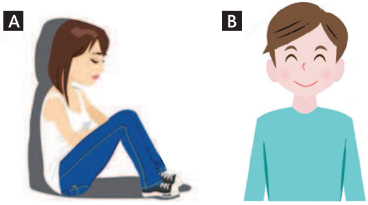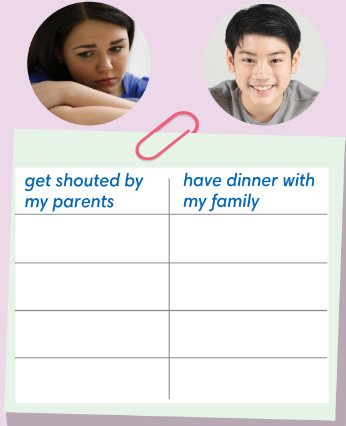Tiếng Anh 8 Unit 4 4.5 Listening and Vocabulary1. Look at the photos. How are these teenagers feeling? What may make the girl in photo A sad? 2. Listen to the conversation between Nancy and Kelly talking about their sons’ problems. Mark the statements T (true) or F (false). 3. Listen again and tick (ü) the words / phrases used for hesitation devices and fillers in the conversation that you can hear. 4. Choose the best summary of the dialogue. 5. The following phrases are from the listening. Choose the suitable phrase to complete the followin Quảng cáo
Lựa chọn câu để xem lời giải nhanh hơn
Bài 1 1. Look at the photos. How are these teenagers feeling? What may make the girl in photo A sad? (Nhìn vào những bức ảnh. Những thanh thiếu niên này cảm thấy thế nào? Điều gì có thể khiến cô gái trong ảnh A buồn?)
Lời giải chi tiết: The female in photo A is continuously crying, meanwhile the guy in photo B is cheerfully smiling. The girl in image A is depressed because she has just been exposed to some kind of pressure. (Cô gái trong bức ảnh A liên tục khóc, trong khi chàng trai trong bức ảnh B đang cười sảng khoái. Cô gái trong ảnh A đang chán nản vì cô ấy vừa phải chịu một loại áp lực nào đó.) Bài 2 2. Listen to the conversation between Nancy and Kelly talking about their sons’ problems. Mark the statements T (true) or F (false). (Hãy nghe cuộc trò chuyện giữa Nancy và Kelly nói về những vấn đề của con trai họ. Đánh dấu các câu T (đúng) hoặc F (sai).) 1. Nancy’s son is no longer sad. (Con trai của Nancy không còn buồn nữa.) 2. Kelly’s son thought his family members were not interested in him. (Con trai của Kelly nghĩ rằng các thành viên trong gia đình không quan tâm đến mình.) 3. Kelly spent more time with her son. (Kelly dành nhiều thời gian hơn cho con trai.) 4. Nancy asks if talking to her son helps him. (Nancy hỏi liệu nói chuyện với con trai cô ấy có giúp ích gì cho anh ấy không.) 5. Kelly was comparing her son with his older brother. (Kelly đang so sánh con trai mình với anh trai của nó.) Lời giải chi tiết: Đang cập nhật! Bài 3 3. Listen again and tick (✓) the words / phrases used for hesitation devices and fillers in the conversation that you can hear. (Nghe lại và đánh dấu (✓) vào các từ/cụm từ dùng cho các thiết bị ngập ngừng và từ lấp đầy trong đoạn hội thoại mà bạn có thể nghe được. 1. Er (Ơ) 2. I see (Tôi hiểu rồi) 3. The thing is … (Vấn đề là…) 4. Um (Ừm) 5. Well (Chà) Lời giải chi tiết: Đang cập nhật! Bài 4 4. Choose the best summary of the dialogue. (Chọn bản tóm tắt tốt nhất của cuộc đối thoại.) 1. Nancy is telling Kelly about teenagers’ problems. (Nancy đang nói với Kelly về những vấn đề của thanh thiếu niên.) 2. Kelly is telling Nancy how she cheered up her son. (Kelly đang nói với Nancy rằng cô ấy đã cổ vũ con trai mình như thế nào.) 3. Nancy is giving Kelly some advice. (Nancy đang cho Kelly một số lời khuyên.) 4. Kelly is asking Nancy how to cheer up her son. (Kelly đang hỏi Nancy cách làm con trai cô ấy vui lên.) Lời giải chi tiết: Đang cập nhật! Bài 5 5. The following phrases are from the listening. Choose the suitable phrase to complete the following sentences. Make changes when necessary. (Các cụm từ sau đây là từ bài nghe. Chọn cụm từ thích hợp để hoàn thành các câu sau. Thực hiện các thay đổi khi cần thiết.)
1. Whenever our family gets together, we _______ with each other. 2. As teenagers grow up, they don’t like their parents to _______ them _______ other people. 3. My boy friend just hung up on me. I think he is not _______ me any more. 4. A: She just broke down when she heard of the news. B: Don’t worry. She will _______ soon. 5. Please cheer up! You will _______ your problem in a few days. 6. Teenagers often want to be _______ their friends because they get along with them. Lời giải chi tiết:
1. Whenever our family gets together, we spend family time with each other. (Bất cứ khi nào gia đình chúng tôi quây quần bên nhau, chúng tôi dành thời gian cho nhau.) 2. As teenagers grow up, they don’t like their parents to compare them with other people. (Khi thanh thiếu niên lớn lên, họ không thích cha mẹ so sánh họ với người khác.) 3. My boyfriend just hung up on me. I think he is not interested in me anymore. (Bạn trai của tôi vừa cúp máy tôi. Tôi nghĩ anh ấy không còn hứng thú với tôi nữa.) 4. A: She just broke down when she heard of the news. (Cô ấy đã khóc không ngừng khi nghe tin.) B: Don’t worry. She will get better soon. (Đừng lo lắng. Cô ấy sẽ tốt lại sớm thôi.) 5. Please cheer up! You will get over your problem in a few days. (Hãy vui lên! Bạn sẽ vượt qua vấn đề của bạn trong một vài ngày.) 6. Teenagers often want to be around their friends because they get along with them. (Thanh thiếu niên thường muốn ở gần bạn bè vì họ hòa đồng với họ.) Bài 6 6. Work in groups. Draw a happy and sad face of two teenagers and write all the activities that makes them happy or sad. Share your drawing and list with your class. (Làm việc nhóm. Vẽ khuôn mặt vui và buồn của hai thiếu niên và viết tất cả các hoạt động khiến họ vui hoặc buồn. Chia sẻ bản vẽ và danh sách của bạn với lớp học của bạn.)
Lời giải chi tiết:
|





















